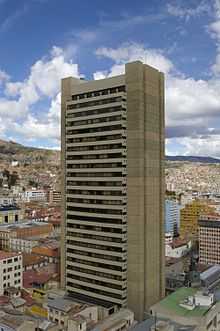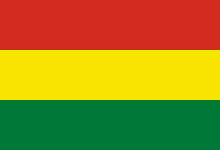Neo-Tiwanakan architecture
| Neo-Tiwanakan architecture | |
|---|---|
 Central Bank of Bolivia built in 1924-1926 | |
| Practice information | |
| Key architects | Emilio Villanueva Peñaranda |
| Location | La Paz |
| Coordinates | 16°30′S 68°09′W / 16.500°S 68.150°W |
| Founded | 1930-1948 |
| Work | |
| Buildings | National museum of archeology, Hernando Siles stadium, Higher University of San Andrés, Central Bank of Bolivia |
| Part of a series on the |
| Culture of Bolivia |
|---|
 |
| History |
| People |
|
|
Festivals |
|
Art
|
|
Literature
|
|
Music and performing arts |
|
Media
|
|
Sport |
|
Monuments
|
|
Symbols |
|
The Neo-Tiwanakan or Pseudo-Tiwanakan architecture is a style developed by the architect Emilio Villanueva Peñaranda between the years 1930 and 1948 inspired in the designs of the Pre-Columbian archeological site of Tiwanaku in Bolivia.[1][2]
Origins
The architect Emilio Villanueva popularized the Neo-Tiwanakan architecture in the city of La Paz during the decade of the 1930s. The inspiration for these designs was the blueprints for ideal reconstructions of Tiwanaku elaborated by Edmund Kiss in 1937; these designs were adapted by Villanueva to give them an urban and contemporaneous style.[1]
Notes
- ↑ 1.0 1.1 Browman, David (2007). La Sociedad arqueológica de Bolivia y su influencia en el desarrollo de la práctica arqueológica en Bolivia [The archeological society of Bolivia and its influence in the development of the archeological practice in Bolivia] (PDF). Nuevos Aportes (in Spanish) 4. La Paz, Bolivia. Retrieved 1 February 2010. Invalid
|name-list-format=scap(help) - ↑ Pérez, Martín; Boero Rojo, Hugo; de la Riva, Miroslava (1990). Unión de Ciudades Capitales Iberoamericanas, ed. Guía de La Paz [La Paz guide]. Guías UCCI (in Spanish) 13. Madrid, Spain. ISBN 978-84-87771-02-6. OCLC 433846494. Invalid
|name-list-format=scap(help)